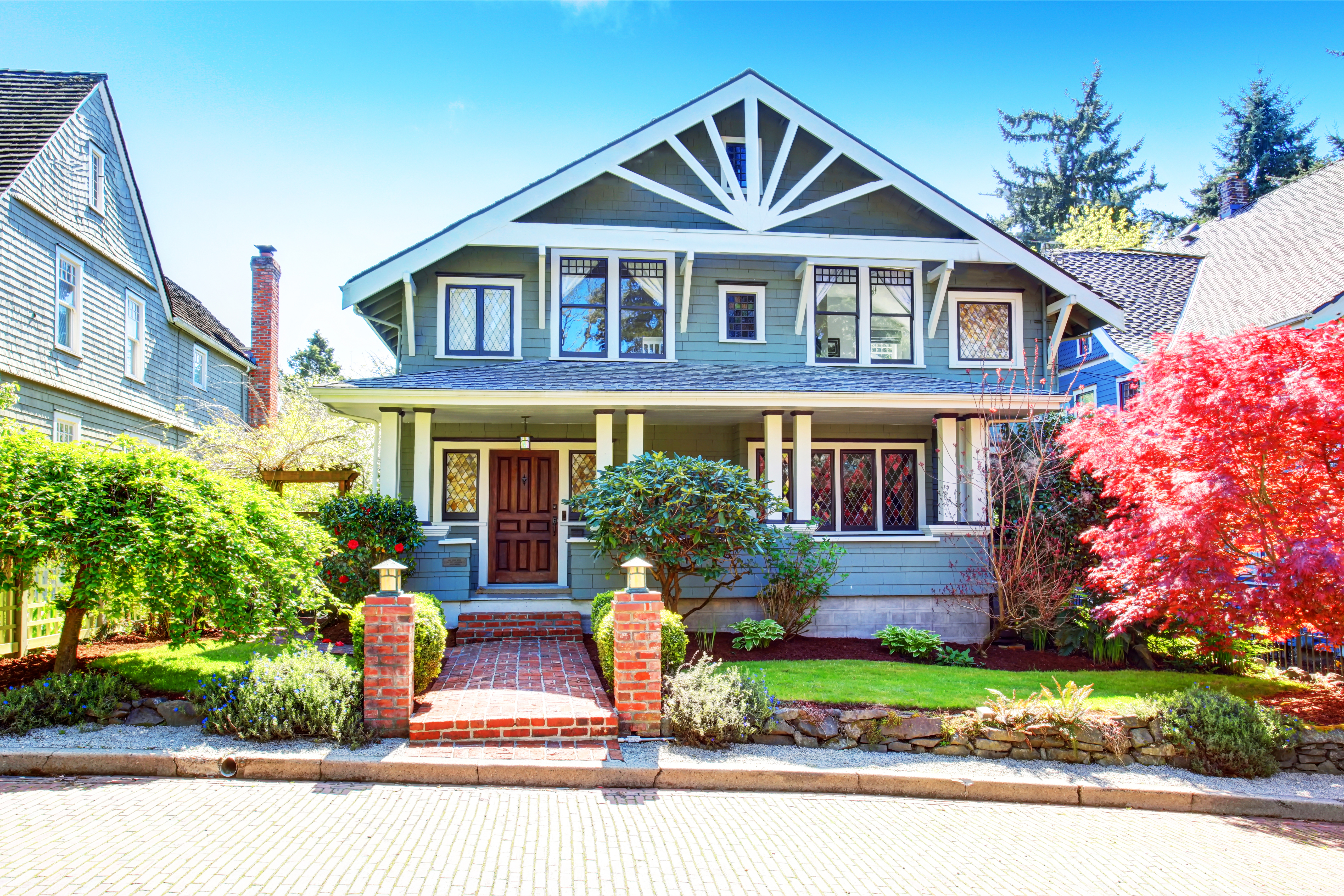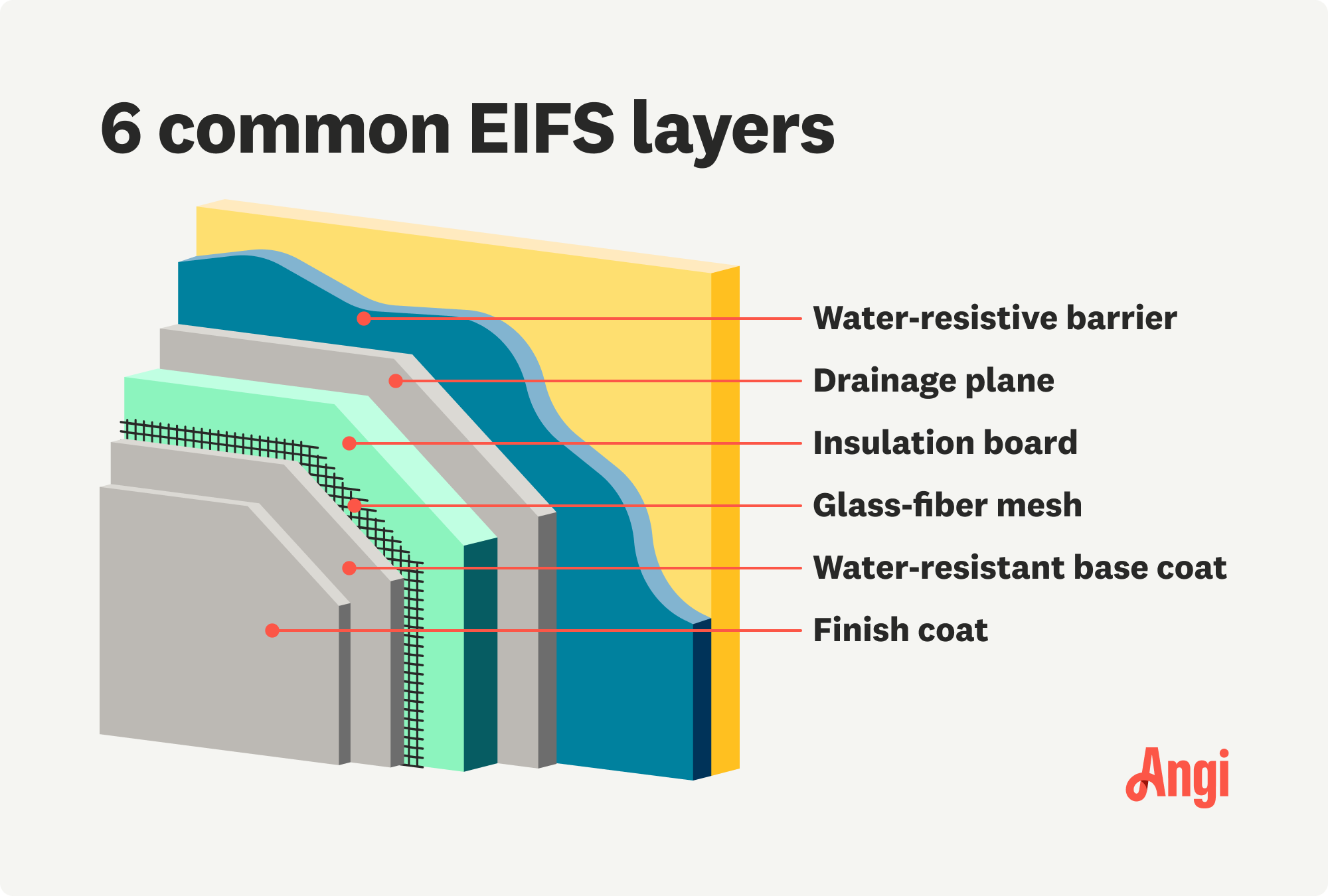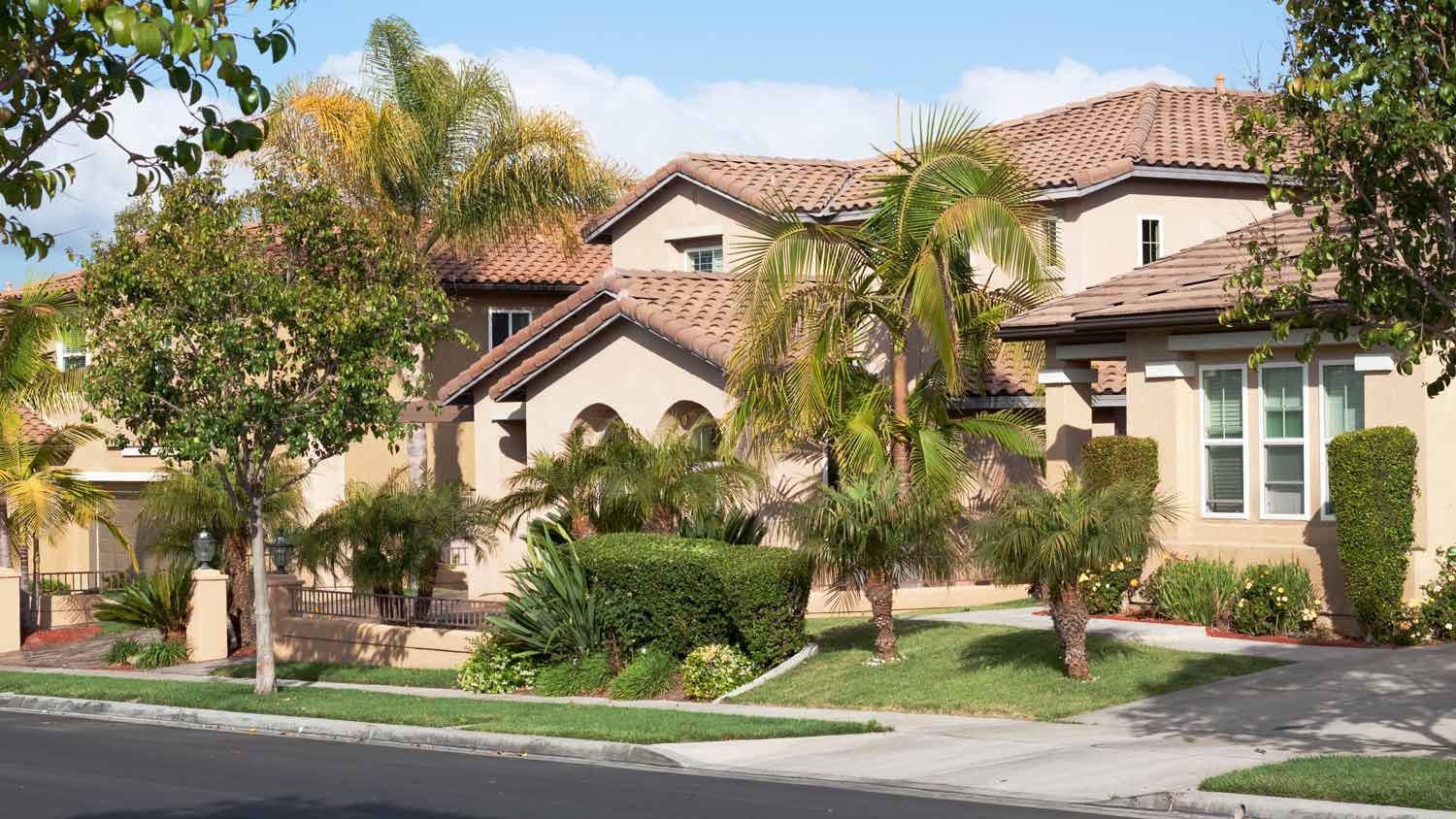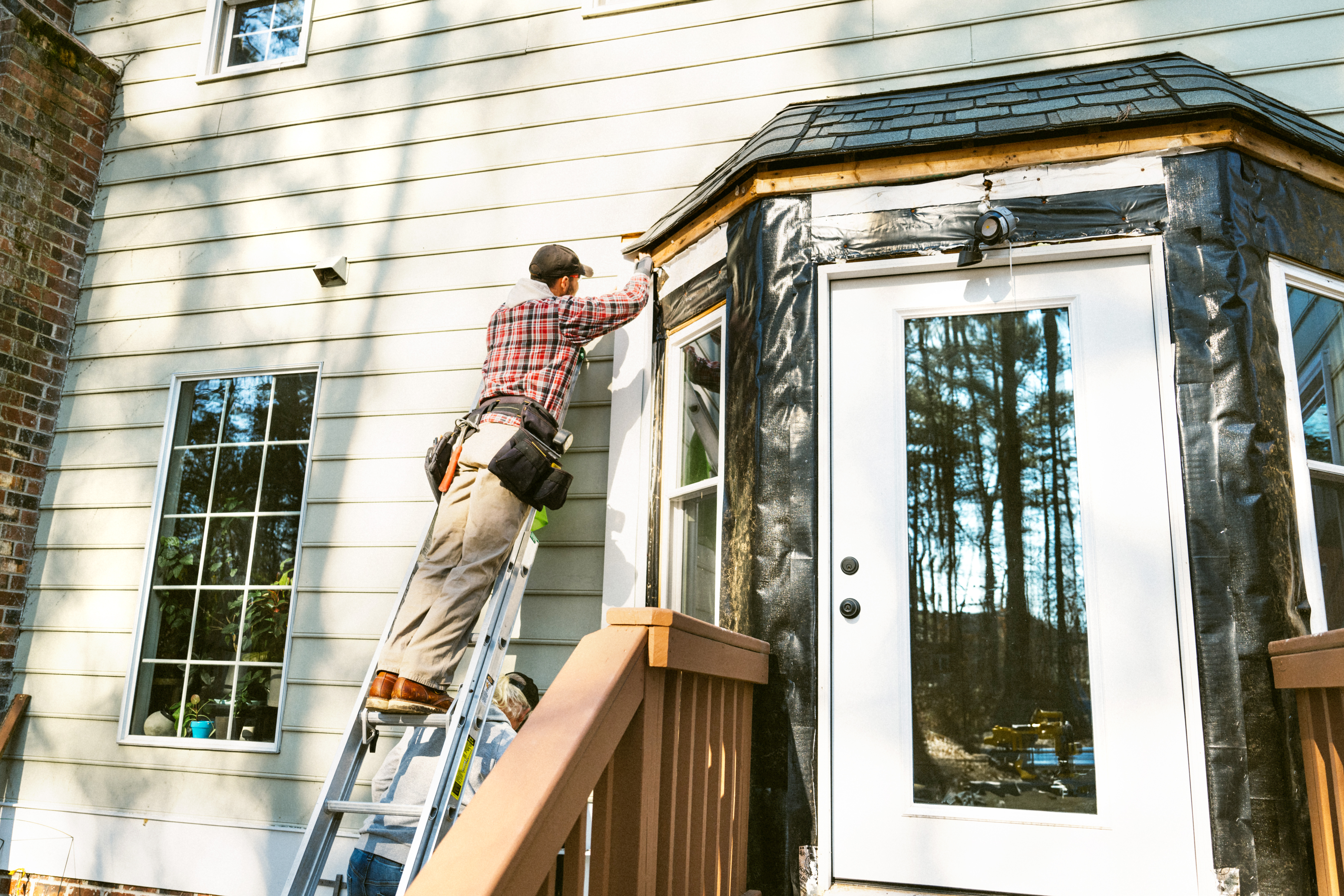
The cost of siding repair varies depending on material, design, and damage. This helpful guide covers the siding repair costs to expect in Columbus, Ohio.
EIFS looks a lot like stucco, but it's a unique material that may just be perfect for your home


EIFS is commonly referred to as “synthetic stucco,” which features six different layers.
EIFS has better insulation and less cracking under fluctuating temperatures compared to stucco.
EIFS is more expensive than stucco.
Choosing the right exterior materials for your home can be tricky, but if you haven’t heard of EIFS, it may be the perfect choice for you. EIFS has its share of both pros and cons, but with a little know-how, you can determine if it’s right for your home. Let’s review the key elements of EIFS siding to help you choose the right option for your home.
Exterior Insulation and Finish Systems, or EIFS, is a type of wall cladding applied to a building’s exterior surfaces. EIFS is also referred to as “synthetic stucco” because it looks very similar to traditional stucco, but it is actually quite different.
The main difference is that stucco consists of two, and sometimes only one, thick layer of original stucco spread over a mesh wire. EIFS, on the other hand, consists of a total of six different layers. It’s also more expensive than stucco.
EIFS first hit the market in Europe after World War II as an energy-efficient and versatile cladding system. It gained popularity in the U.S. during the 1970s due to its ability to improve a building's energy efficiency by providing insulation and a weather-resistant finish.
When taking on this project, expect questions only a pro can answer. With our network of local pros, you'll get the job done and your questions answered—without the hassle and stress of doing it yourself.

Present-day EIFS has been upgraded from earlier versions and now has six layers:
1. A water-resistive barrier (WRB)
2. The addition of a drainage plane between the WRB and the insulation board that lets water drain out from behind the cladding
3. Insulation board that is usually made of expanded polystyrene (EPS)
4. Glass-fiber reinforcing mesh embedded in the base coat
5. A water-resistant base coat that’s applied on top of the insulation
6. A finish coat to prevent cracks
No siding comes without pros and cons, and EIFS is no exception. This type of siding, while often more expensive upfront than other budget-friendly options, has plenty of pros to make the upfront cost worth considering. However, it helps to have a full understanding of the benefits and drawbacks of EIFS before making a decision.
| Pros of EIFS | Cons of EIFS |
|---|---|
| Energy efficient | Higher upfront cost |
| Durable | Complex installation |
| Customizable | Trapped moisture can lead to mold growth |
| Less susceptible to temperature changes | Harder to clean |
Exterior Insulation and Finish Systems have many advantages when compared to other common exterior finishes, including:
More energy-efficient than conventional stucco over time
Weighs around 80% less than traditional stucco, despite the number of layers
Flexible, making it less susceptible to damage from drastic changes in temperatures
More durable than traditional stucco
Can shed water and be sealed at the windows and other openings, making it hard for water to leak in
Can be installed in a variety of textures and colors to make your home's exterior stand out
EIFS installations also have several disadvantages, including:
Installation is complex and uses more materials than some other exterior finishes, so it can be expensive
If EIFS siding needs replacement, the cost can be as high as $16 per square foot. Stucco costs an average of $6 to $9 per square foot
EIFS layers can’t breathe, which can allow moisture to become trapped and cause damage, including mold. But this depends in part on the installation
EIFS can require frequent inspections because of the potential of water seepage
Can be hard to clean and may need regular pressure washing
Although EIFS can be more costly to install than other siding materials, it tends to have less lifetime costs compared to its counterpart, which is traditional stucco. EIFS costs around $8 to $14 per square foot fully installed, as opposed to stucco which usually ranges from $7 to $9 fully installed. A traditional home with about 2,000 square feet of EIFS siding will cost between $16,500 and $27,500 for EIFS siding.
EIFS is an ideal siding option in a wide range of climates and conditions, so where you live won’t necessarily be the deciding factor on when to use it. However, if the exterior aesthetic of your home is a priority and you prefer the look of stucco with more customization, EIFS is the right type of siding for you. It comes in a variety of textures and colors, so if you’re looking to match a specific style or design, EIFS is an excellent option.

The biggest problem many have had with EIFS in the past is that it can allow moisture to become trapped within the layers and cause significant damage to your home. Without an inspection, this damage can go undetected until mold and rot have damaged the structure, causing expensive repairs.
However, over the past several years, the industry has gone to great lengths to improve its durability and eliminate any problems with trapped moisture. Today, EIFS is more flexible and has a higher R-value than traditional stucco, which means better insulation and less cracking as a result of fluctuating temperatures. The fiberglass layer provides more durability against harsh weather, making it a good choice in very hot or very cold temperatures.
If you’re considering installing EIFS, contact a local siding contractor to confirm whether it’s a good fit for your home size and location, and then schedule the installation.
From average costs to expert advice, get all the answers you need to get your job done.

The cost of siding repair varies depending on material, design, and damage. This helpful guide covers the siding repair costs to expect in Columbus, Ohio.

Fiber cement siding is durable, fire-resistant, and affordable. Learn more about fiber cement installation costs in Columbus, OH.

New vinyl siding adds value and curb appeal to homes in Columbus, Ohio. Learn about average vinyl siding installation costs in Columbus, Ohio.

Find out the true cost to install T1-11 siding on your home. Get detailed price breakdowns, installation tips, and ways to save on your siding project.

Are you looking at stucco versus vinyl siding? Use our guide to compare their pros, cons, and costs so you can make the best choice for your home.

If you have woodpeckers pecking on your house, you may be at your wit's end. Read this to learn how to stop woodpeckers from pecking your house.